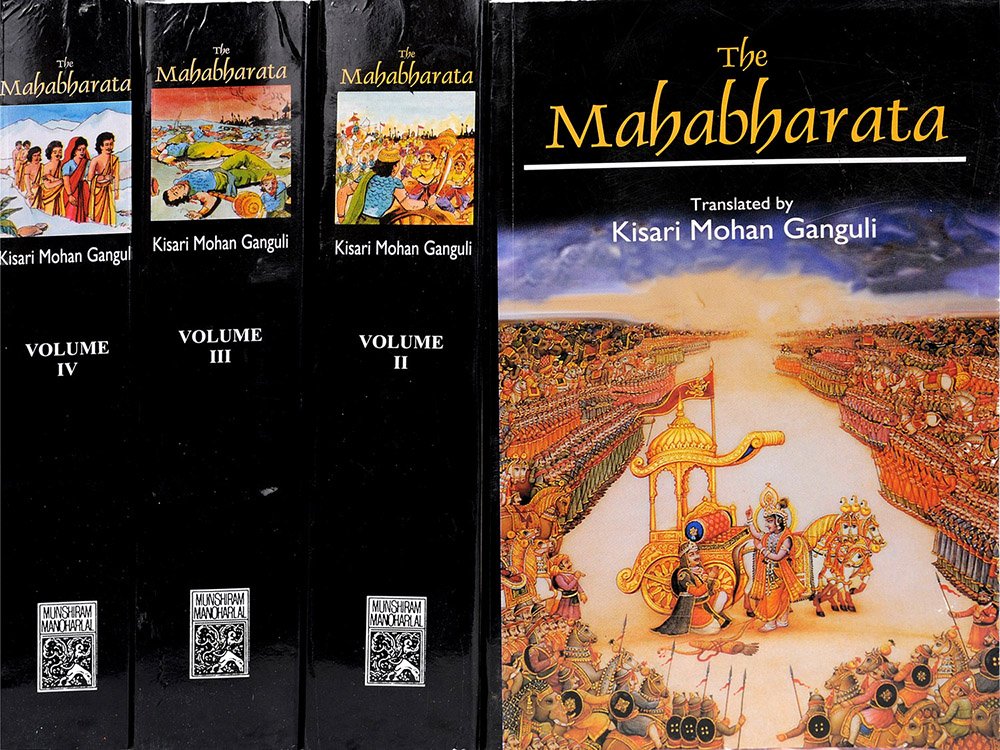Mahabharata (English)
by Kisari Mohan Ganguli | 2,566,952 words | ISBN-10: 8121505933
The English translation of the Mahabharata is a large text describing ancient India. It is authored by Krishna-Dwaipayana Vyasa and contains the records of ancient humans. Also, it documents the fate of the Kauravas and the Pandavas family. Another part of the large contents, deal with many philosophical dialogues such as the goals of life. Book...
Section CLXXXV
"Markandeya continued,
'O you conqueror of hostile cities, in this connection Sarasvati too, when interrogated by that intelligent Muni Tarkshya, had said (this). Do you listen to her words! Tarkshya had asked, saying, 'Excellent lady, what is the best thing for a man to do here below, and how must he act so that he may not deviate from (the path of) virtue. Tell me all this, O beautiful lady, so that instructed by you, I may not fall away from the path of virtue! When and how must one offer oblations to the (sacred) fire and when must he worship so that virtue may not be compromised? Tell me all this, O excellent lady, so that I may live without any passions, craving, or desire, in this world.'
"Markandeya continued,
'Thus questioned by that cheerful Muni and seeing him eager to learn and endued with high intelligence, Sarasvati addressed these pious and beneficial words to the Brahmana, Tarkshya.'
"Sarasvati said,
'He who is engaged in the study of the Vedas, and with sanctity and equanimity perceives the supreme Godhead in his proper sphere, ascends the celestial regions and attains supreme beatitude with the Immortals. Many large, beautiful, pellucid and sacred lakes are there, abounding with fish, flowers, and golden lilies. They are like shrines and their very sight is calculated to assuage grief. Pious men, distinctively worshipped by virtuous well-adorned golden-complexioned Apsaras, dwell in contentment on the shores of those lakes.
He who gives cows (to Brahmanas) attains the highest regions; by giving bullocks he reaches the solar regions, by giving clothes he gets to the lunar world, and by giving gold he attains to the state of the Immortals.
He who gives a beautiful cow with a fine calf, and which is easily milked and which does not run away, is (destined) to live for as many years in the celestial regions as there are hairs on the body of that animal.
He who gives a fine, strong, powerful, young bullock, capable of drawing the plough and bearing burdens, reaches the regions attained by men who give ten cows. When a man bestows a well-caparisoned kapila cow with a brazen milk-pail and with money given afterwards, that cow becoming, by its own distinguished qualities, a giver of everything reaches the side of the man who gave her away.
He who gives away cows, reaps innumerable fruits of his action, measured by the hairs on the body of that animal. He also saves (from perdition) in the next world his sons and grandsons and ancestors to the seventh generation.
He who presents to a Brahmana, sesamum made up in the form of a cow, having horns made of gold, with money besides, and a brazen milk-pail, subsequently attains easily to the regions of the Vasus. By his own acts man descends into the darksome lower regions, infested by evil spirits (of his own passions) like a ship tossed by the storm in the high seas; but the gift of kine to Brahmanas saves him in the next world.
He who gives his daughter in marriage, in the Brahma form, who bestows gifts of land on Brahmanas and who duly makes other presents, attains to the regions of Purandara. O Tarkshya, the virtuous man who is constant in presenting oblations to the sacred fire for seven years, sanctifies by his own action seven generations up and down.'
"Tarkshya said,
'O beautiful lady, explain to me who ask you, the rules for the maintenance of the sacred fire as inculcated in the Vedas. I shall now learn from you the time-honoured rules for perpetually keeping up the sacred fire.'"
Conclusion:
This concludes Section CLXXXV of Book 3 (Vana Parva) of the Mahabharata, of which an English translation is presented on this page. This book is famous as one of the Itihasa, similair in content to the eighteen Puranas. Book 3 is one of the eighteen books comprising roughly 100,000 Sanskrit metrical verses.
FAQ (frequently asked questions):
Which keywords occur in Section CLXXXV of Book 3 of the Mahabharata?
The most relevant definitions are: Tarkshya, Brahmana, Sarasvati, Brahmanas, Markandeya, Muni; since these occur the most in Book 3, Section CLXXXV. There are a total of 12 unique keywords found in this section mentioned 27 times.
What is the name of the Parva containing Section CLXXXV of Book 3?
Section CLXXXV is part of the Markandeya-Samasya Parva which itself is a sub-section of Book 3 (Vana Parva). The Markandeya-Samasya Parva contains a total of 50 sections while Book 3 contains a total of 13 such Parvas.
Can I buy a print edition of Section CLXXXV as contained in Book 3?
Yes! The print edition of the Mahabharata contains the English translation of Section CLXXXV of Book 3 and can be bought on the main page. The author is Kisari Mohan Ganguli and the latest edition (including Section CLXXXV) is from 2012.
